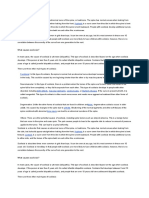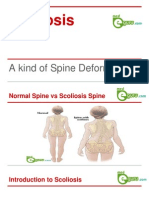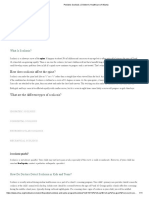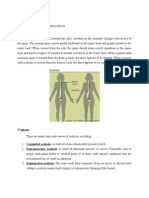Scolio
Scolio
Uploaded by
Jonahh2012Original Description:
Original Title
Copyright
Available Formats
Share this document
Did you find this document useful?
Is this content inappropriate?
Report this DocumentCopyright:
Available Formats
Scolio
Scolio
Uploaded by
Jonahh2012Copyright:
Available Formats
Scoliosis is a disorder that causes an abnormal curve of the spine, or backbone.
The spine has normal curves when looking from the side, but it should appear straight when looking from the front. Scoliosis is about two times more common in girls than boys. It can be seen at any age, but it is most common in those over 10 years of age. Scoliosis is hereditary in that people with scoliosis are more likely to have children with scoliosis; however, there is no correlation between the severity of the curve from one generation to the next.
Signs and Symptoms
abnormal curve of the spine clothes do not fit as they did previously or that pant legs are longer on one side that the other. may cause the head to appear off center or one hip or shoulder to be higher than the opposite side more obvious curve on one side of the rib cage on your back from twisting of the vertebrae and ribs If the scoliosis is more severe, it can make it more difficult for the heart and lungs to work properly can cause shortness of breath and chest pain. scoliosis is not painful certain types of scoliosis than can cause back pain
Diagnosis :
Physical Examination involves looking at the curve of the spine from the sides, front, and back X-rays of the back MRI CT scan Prognosis :
Most people with scoliosis can live full, productive, and normal lives. People with scoliosis are able to become pregnant and have children with no increased risk for complications. They may be at increased risk for additional low back pain during pregnancy. Newer advances in surgery have allowed for less invasive surgical methods that have less pain and shorter recovery periods.
These techniques are still being developed, but the initial results are very promising.
Treatment :
Functional scoliosis - small wedge can be placed in the shoe to help even out the leg length and prevent the spine from curving.
Neuromuscular scoliosis - majority of these people will eventually need surgery to stop the curve from getting worse.
Juvenile idiopathic scoliosis - Bracing can be tried early if the curve is not very severe.
Adolescent idiopathic scoliosis - If the curve stays below 25 degrees, no other treatment is needed.
If the curve is between 25-40 degrees and you are still growing, a brace may be
recommended. Bracing is not recommended for people who have finished growing.
If the curve is greater than 40 degrees, then surgery may be recommended.
You might also like
- Anatomy of ScoliosisDocument6 pagesAnatomy of ScoliosisDaniel MañalacNo ratings yet
- Scoliosis, Kyphosis, LordosisDocument54 pagesScoliosis, Kyphosis, LordosisMj Briones100% (1)
- ScoliosisDocument5 pagesScoliosisIbe JulienneNo ratings yet
- ScoliosisDocument5 pagesScoliosisIbe JulienneNo ratings yet
- Scoliosis: By: Manilyn B. Lin Bsn-IiiDocument13 pagesScoliosis: By: Manilyn B. Lin Bsn-IiiWillie100% (1)
- NCP ScoliosisDocument4 pagesNCP ScoliosisCharley DegamoNo ratings yet
- Scoliosis Tcm75 464820Document2 pagesScoliosis Tcm75 464820Mohamed MagdyNo ratings yet
- ScolioDocument2 pagesScolioJester de ChavezNo ratings yet
- About:: Birth Defects Muscular Dystrophy, Cerebral Palsy Marfan's DiseaseDocument4 pagesAbout:: Birth Defects Muscular Dystrophy, Cerebral Palsy Marfan's DiseaseAbie BeyNo ratings yet
- ScoliosisDocument4 pagesScoliosisDharline Abbygale Garvida AgullanaNo ratings yet
- About Scoliosis PDFDocument7 pagesAbout Scoliosis PDFNiessha ZuhrotulNo ratings yet
- About ScoliosisDocument3 pagesAbout ScoliosisTrixia BautistaNo ratings yet
- ScoliosisDocument3 pagesScoliosisTracy100% (1)
- Scoliosis Surgery IannnDocument8 pagesScoliosis Surgery IannnAnie ZacariasNo ratings yet
- Scoliosis in Children and Teens enDocument8 pagesScoliosis in Children and Teens enEva-Lena RehnströmNo ratings yet
- Kyphosis Lordosis: What Causes Scoliosis?Document3 pagesKyphosis Lordosis: What Causes Scoliosis?Jian LadaoNo ratings yet
- KiposisDocument13 pagesKiposisHidaya UlyaaNo ratings yet
- Scoliosis: A Kind of Spine DeformityDocument6 pagesScoliosis: A Kind of Spine DeformityAnvitatoursNo ratings yet
- ScoliosisDocument19 pagesScoliosisMia Dela CruzNo ratings yet
- Scoliosis: Spinal Curvature, KyphoscoliosisDocument3 pagesScoliosis: Spinal Curvature, Kyphoscoliosisiamweena17No ratings yet
- Scoliosis and KyphosisDocument5 pagesScoliosis and KyphosisEufrasia VictaNo ratings yet
- Types of Spine Curvature DisordersDocument7 pagesTypes of Spine Curvature DisordersNicu MacariNo ratings yet
- Kyphosis - Symptoms - Causes - TreatmentDocument5 pagesKyphosis - Symptoms - Causes - TreatmentMara ColegiuNo ratings yet
- ScoliosisDocument9 pagesScoliosisapi-302888135No ratings yet
- Scoliosis, (Updated) A Simple Guide To The Condition, Diagnosis, Treatment And Related ConditionsFrom EverandScoliosis, (Updated) A Simple Guide To The Condition, Diagnosis, Treatment And Related ConditionsNo ratings yet
- Figure FaultsDocument17 pagesFigure FaultsMichael SimpsonNo ratings yet
- C-Shaped Curve: Presented By: Elorde, Charisma CDocument6 pagesC-Shaped Curve: Presented By: Elorde, Charisma CCharisma ElordeNo ratings yet
- Scolio SIS: Submitted ToDocument10 pagesScolio SIS: Submitted Tojean thereseNo ratings yet
- Scoliosis Disease OverviewDocument7 pagesScoliosis Disease OverviewReema Akberali nooraniNo ratings yet
- Pilates For ScoliosisDocument13 pagesPilates For ScoliosisIoan-Alexandru CodarceaNo ratings yet
- KyphosisDocument4 pagesKyphosisclubsanatateNo ratings yet
- ScoliosisDocument25 pagesScoliosisshanel18100% (1)
- Musculoskeletal Dysfunction in ChildrenDocument40 pagesMusculoskeletal Dysfunction in Childrensanakhan091197No ratings yet
- ScoliosisDocument9 pagesScoliosisLorebell80% (5)
- How Does Scoliosis Affect The Spine?Document11 pagesHow Does Scoliosis Affect The Spine?Eddy ZayasNo ratings yet
- Types of ScoliosisDocument5 pagesTypes of ScoliosisDimple Castañeto CalloNo ratings yet
- A Comprehensive Study On Marma PointsDocument9 pagesA Comprehensive Study On Marma Pointsaaronjdriver2248100% (1)
- Scoliosis 2Document2 pagesScoliosis 2api-264893632No ratings yet
- Poc ScoliosisDocument20 pagesPoc ScoliosisSugar Capule - ManuelNo ratings yet
- Idiopathic Scoliosis AdolescentsDocument10 pagesIdiopathic Scoliosis AdolescentscahyaningarumNo ratings yet
- Scoliosis Fact SheetDocument3 pagesScoliosis Fact SheetTSRHCNo ratings yet
- ScoliosisDocument3 pagesScoliosisWilliam D. NarvaezNo ratings yet
- ScoliosisDocument18 pagesScoliosisMj EnofnaNo ratings yet
- Scoliosis: Ns. M. Nurman, S.Kep Stikes Tuanku Tambusai BangkinangDocument36 pagesScoliosis: Ns. M. Nurman, S.Kep Stikes Tuanku Tambusai Bangkinangwindy noviantyNo ratings yet
- Pediatric Scoliosis What Is Scoliosis?Document8 pagesPediatric Scoliosis What Is Scoliosis?Yak NafarNo ratings yet
- ScoliosisDocument3 pagesScoliosisannkramNo ratings yet
- Ankylosing SpondylitisDocument29 pagesAnkylosing SpondylitisKrisna ajiNo ratings yet
- Scoliosis: Laguna College San Pablo CityDocument5 pagesScoliosis: Laguna College San Pablo CitychristianjomariNo ratings yet
- Share 'DEFORMITIES - PPTX'Document105 pagesShare 'DEFORMITIES - PPTX'Hunaid 1000No ratings yet
- Case Presentation ScoliosisDocument7 pagesCase Presentation ScoliosisKhrizjan RebloraNo ratings yet
- SCOLIOSISDocument19 pagesSCOLIOSISEspers BluesNo ratings yet
- 25 Congenital Scoliosis (Dr. Fazl Karam)Document45 pages25 Congenital Scoliosis (Dr. Fazl Karam)Dev ZunigaNo ratings yet
- DefinitionDocument25 pagesDefinitiondjustiela karrangNo ratings yet
- ScoliosisDocument1 pageScoliosisKimberly Loide TimtimNo ratings yet
- What Is KyphosisDocument6 pagesWhat Is Kyphosisسانو روديلNo ratings yet
- 25 Congenital DR Fazl Karam)Document45 pages25 Congenital DR Fazl Karam)Himanshu NarangNo ratings yet
- ScoliosisDocument22 pagesScoliosisSanghmitra MauryaNo ratings yet
- ScoliosisDocument13 pagesScoliosisapi-388790663No ratings yet
- Yoga for Scoliosis: A Beginner’s 3-Step Quick Start Guide on Managing Scoliosis Through Yoga and the Ayurvedic Diet, with Sample RecipesFrom EverandYoga for Scoliosis: A Beginner’s 3-Step Quick Start Guide on Managing Scoliosis Through Yoga and the Ayurvedic Diet, with Sample RecipesNo ratings yet



























































